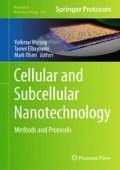Abstract
Mechanical stress affects various aspects of cell behavior, including cell growth, morphology, differentiation, and genetic expression. Here, we describe a method to quantify the intracellular mechanical response to an extracellular mechanical perturbation, specifically the displacement of mitochondria. A combined fluorescent-atomic force microscope (AFM) was used to simultaneously produce well-defined nanomechanical stimulation to a living cell while optically recording the real-time displacement of fluorescently labeled mitochondria. A single-particle tracking (SPT) approach was then applied in order to quantify the two-dimensional displacement of mitochondria in response to local forces.
Access this chapter
Tax calculation will be finalised at checkout
Purchases are for personal use only
References
Binnig G, Quate CF, Gerber C (1986) Atomic force microscope. Phys Rev Lett 56:930–933
Putman CA, van der Werf KO, de Grooth BG, van Hulst NF, Greve J (1994) Viscoelasticity of living cells allows high resolution imaging by tapping mode atomic force microscopy. Biophys J 67:1749–1753
Radmacher M, Tillmann RW, Fritz M, Gaub HE (1992) From molecules to cells—imaging soft samples with the atomic force microscope. Science 257:1900–1905
Charras G, Horton MA (2001) Cellular mechanotransduction and its modulation: an atomic force microscopy study. Biophys J 80:305A–306A
Rotsch C, Jacobson K, Radmacher M (1999) Dimensional and mechanical dynamics of active and stable edges in motile fibroblasts investigated by using atomic force microscopy. Proc Natl Acad Sci USA 96:921–926
Pelling AE, Sehati S, Gralla EB, Valentine JS, Gimzewski JK (2004) Local nanomechanical motion of the cell wall of Saccharomyces cerevisiae. Science 305:1147–1150
Haupt BJ, Pelling AE, Horton MA (2006) Integrated confocal and scanning probe microscopy for biomedical research. ScientificWorldJournal 6:1609–1618
Horton M, Charras G, Ballestrem C, Lehenkari P (2000) Integration of atomic force and confocal microscopy. Single Mol 1:135–137
Lehenkari PP, Charras GT, Nykänen A, Horton MA (2000) Adapting atomic force microscopy for cell biology. Ultramicroscopy 82:289–295
Bereiterhahn J, Voth M (1994) Dynamics of mitochondria in living cells—shape changes, dislocations, fusion, and fission of mitochondria. Microsc Res Tech 27:198–219
Brady S, Lasek R, Allen R (1982) Fast axonal transport in extruded axoplasm from squid giant axon. Science 218:1129–1131
Heggeness MH, Simon M, Singer SJ (1978) Association of mitochondria with microtubules in cultured cells. Proc Natl Acad Sci USA 75:3863–3866
Morris R, Hollenbeck P (1995) Axonal transport of mitochondria along microtubules and F-actin in living vertebrate neurons. J Cell Biol 131:1315–1326
Drubin D, Jones H, Wertman K (1993) Actin structure and function: roles in mitochondrial organization and morphogenesis in budding yeast and identification of the phalloidin-binding site. Mol Biol Cell 4:1277–1294
Rudiger Suelmann RF (2000) Mitochondrial movement and morphology depend on an intact actin cytoskeleton in Aspergillus nidulans. Cell Motil Cytoskeleton 45:42–50
Wang N, Butler JP, Ingber DE (1993) Mechanotransduction across the cell-surface and through the cytoskeleton. Science 260:1124–1127
Alenghat FJ, Ingber DE (2002) Mechanotransduction: all signals point to cytoskeleton, matrix, and integrins. Sci STKE 2002:pe6
Blumenfeld R (2006) Isostaticity and controlled force transmission in the cytoskeleton: a model awaiting experimental evidence. Biophys J 91:1970–1983
Sbalzarini IF, Koumoutsakos P (2005) Feature point tracking and trajectory analysis for video imaging in cell biology. J Struct Biol 151:182–195
Silberberg YR, Pelling AE, Yakubov GE, Crum WR, Hawkes DJ, Horton MA (2008) Tracking displacements of intracellular organelles in response to nanomechanical forces, presented at Biomedical imaging: from nano to macro, 2008. ISBI 2008. 5th IEEE international symposium on 14–17 May 2008, Paris, France. pp 1335–1338
Silberberg YR, Pelling AE, Yakubov GE, Crum WR, Hawkes DJ, Horton MA (2008) Mitochondrial displacements in response to nanomechanical forces. J Mol Recognit 21:30–36
Levy R, Maaloum M (2002) Measuring the spring constant of atomic force microscope cantilevers: thermal fluctuations and other methods. Nanotechnology 13:33–37
Acknowledgments
Y.R.S. would like to thank the Japanese Society for the Promotion of Science (JSPS) for a post-doctoral fellowship grant. A.E.P. acknowledges generous support from the Canada Research Chairs program, the Province of Ontario Early Researcher Award, and the Natural Sciences and Engineering Research Council. The authors would like to gratefully acknowledge the tremendous support and mentorship of Professor Michael Horton (1948–2010) and his inspiration for this work.
Author information
Authors and Affiliations
Editor information
Editors and Affiliations
Rights and permissions
Copyright information
© 2013 Springer Science+Business Media New York
About this protocol
Cite this protocol
Silberberg, Y.R., Pelling, A.E. (2013). Quantification of Intracellular Mitochondrial Displacements in Response to Nanomechanical Forces. In: Weissig, V., Elbayoumi, T., Olsen, M. (eds) Cellular and Subcellular Nanotechnology. Methods in Molecular Biology, vol 991. Humana Press, Totowa, NJ. https://doi.org/10.1007/978-1-62703-336-7_18
Download citation
DOI: https://doi.org/10.1007/978-1-62703-336-7_18
Published:
Publisher Name: Humana Press, Totowa, NJ
Print ISBN: 978-1-62703-335-0
Online ISBN: 978-1-62703-336-7
eBook Packages: Springer Protocols

